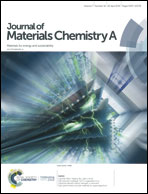Grain boundaries modified uniformly-conjoint metal/oxides via binder strategy as efficient bifunctional electrocatalysts†
Abstract
Defect engineering through grain boundaries, disordered regions, and atomic vacancies has the potential to achieve novel physical and chemical properties by modulating the atomic arrangements and electronic configurations. In particular, grain boundaries facilitates superior synergistic effects of different crystals. This work proposes an ingenious binder strategy to introduce grain boundaries in metal/semiconductor (M/MOx, M = Co, Ni) architectures via the thermal calcination of layered Co/Ni glycerolates bonded by melamine. XAFS and HRTEM results illustrate the abundant grain boundaries and disordered regions among the different crystals. DFT calculations demonstrate that the metal/semiconductor composite has metallic electrical conductivity with fast electron mobility, and the deformation of the electronic structure at the interface produces abundant reactive sites to improve the intrinsic activity. Therefore, this architecture (CoNim) shows excellent properties for electrocatalytic OER and ORR with a potential gap of 0.72 V at 10 mA cm−2, good stability (>13 h for OER and >29 h for ORR) and perfect selectivity (electron transfer number, N = 4.0). As an air electrode for Zn–air batteries, it shows a long discharge time (23 h) and a peak power density of 81.7 mW cm−2. The facile binder strategy provides a new defect manufacturing method for the development of highly efficient bifunctional nanomaterials to be applied in energy devices.



 Please wait while we load your content...
Please wait while we load your content...